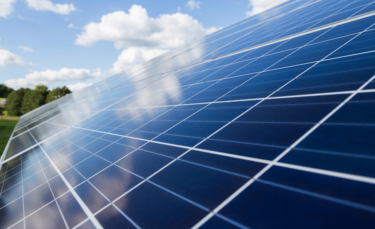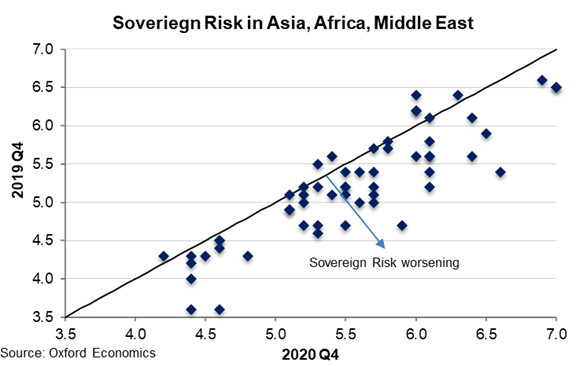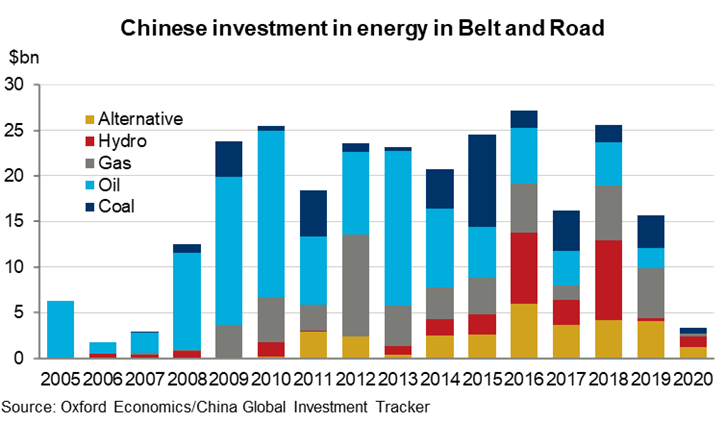Blog | 25 Mar 2021
China’s opportunity to show climate leadership in 2021

Tom Rogers
Associate Director, Capital Projects and Assets Consulting

Few policy issues are attracting more attention than how to leverage the post-COVID recovery to accelerate the transition to a low-carbon economy. Europe’s Green Deal aims to mobilise €1trn in sustainable investment over the coming decade, President Biden campaigned on a promise to unleash $2trn in clean investment in the US over his first term, and Japan’s ruling party has urged its leadership to follow suit with a fund “comparable to global standards” to help finance Japan’s low-carbon transition.
These major investment programmes are a key step to a low-carbon future. But financing the transition might be less daunting in advanced economies—where the burden of servicing government debt has consistently eased through the past couple of decades—than in emerging economies, where sovereign risk has risen over the last year. Even though financial conditions for emerging markets remain relatively favourable for now, governments in emerging economies will be conscious of the need to narrow fiscal deficits, reduce debt burdens, and steer key sovereign risk metrics back in a favourable direction. So financing the transition may take a back seat to balancing the books, at least in the short term.
 The current economic landscape also provides China with an important opportunity—to deliver on President Xi’s 2019 pledge to build “high-quality, sustainable, risk-resistant, reasonably priced, and inclusive infrastructure” across the Belt and Road Initiative (BRI). Our 2019 report, Belt and Road Green Finance Index, highlighted the financial constraints many countries in the Belt and Road will face in shifting to low carbon—challenges that have only intensified by the events of the past year. But our report also looked at the potential role for China and other BRI members to support this transition via financial support and technological diffusion.
The current economic landscape also provides China with an important opportunity—to deliver on President Xi’s 2019 pledge to build “high-quality, sustainable, risk-resistant, reasonably priced, and inclusive infrastructure” across the Belt and Road Initiative (BRI). Our 2019 report, Belt and Road Green Finance Index, highlighted the financial constraints many countries in the Belt and Road will face in shifting to low carbon—challenges that have only intensified by the events of the past year. But our report also looked at the potential role for China and other BRI members to support this transition via financial support and technological diffusion.
What specifically could China do? One option would be to accelerate investment in clean energy along the Belt and Road, which understandably stalled in 2020. But even before the pandemic, alternatives only formed a small part of China’s outbound energy investment. This contrasts with its domestic achievements—China has gone from almost a standing start in 2015 to having as much installed solar capacity as the US and Europe put together, and in 2019 added more than Japan, India, South Korea, Australia and Vietnam combined. By providing the financial inputs and know-how, and working with local labour, China could support a powerful short-term driver of recovery. For example, an analysis of Cyprus by the World Bank found that incentivising solar capacity installation had the greatest short-term employment impact among a range of “Green Recovery” measures, and by far the greatest long-term carbon savings.
Supporting short-term demand at the same time as accelerating the transition to clean energy would clearly be a win-win for China’s Belt and Road partners, as well as the global recovery and transition to low carbon. China could prioritise this in its outbound investment though 2021, and arrive at November’s COP 26 having demonstrated a leadership role in supporting the transition in emerging economies. Will China take up the challenge?

Tags:
You may be interested in

Post
Mapping the Plastics Value Chain: A framework to understand the socio-economic impacts of a production cap on virgin plastics
The International Council of Chemical Associations (ICCA) commissioned Oxford Economics to undertake a research program to explore the socio-economic and environmental implications of policy interventions that could be used to reduce plastic pollution, with a focus on a global production cap on primary plastic polymers.
Find Out More
Post
How Canada’s wildfires could affect American house prices
The Northern Hemisphere is now heading into the 2024 fire season, having just had its hottest winter on record. If it is anything like last year, we can expect to see further impacts on people, nature, and global markets.
Find Out More
Post
Beyond assumptions – the dynamics of climate migration
Millions of people have already been displaced because of environmental shocks, but many aspects of climate migration remain poorly understood. This confusion has led to oversimplified assumptions about its causes and effects – in reality, it’s more complicated and has many nuances.
Find Out More